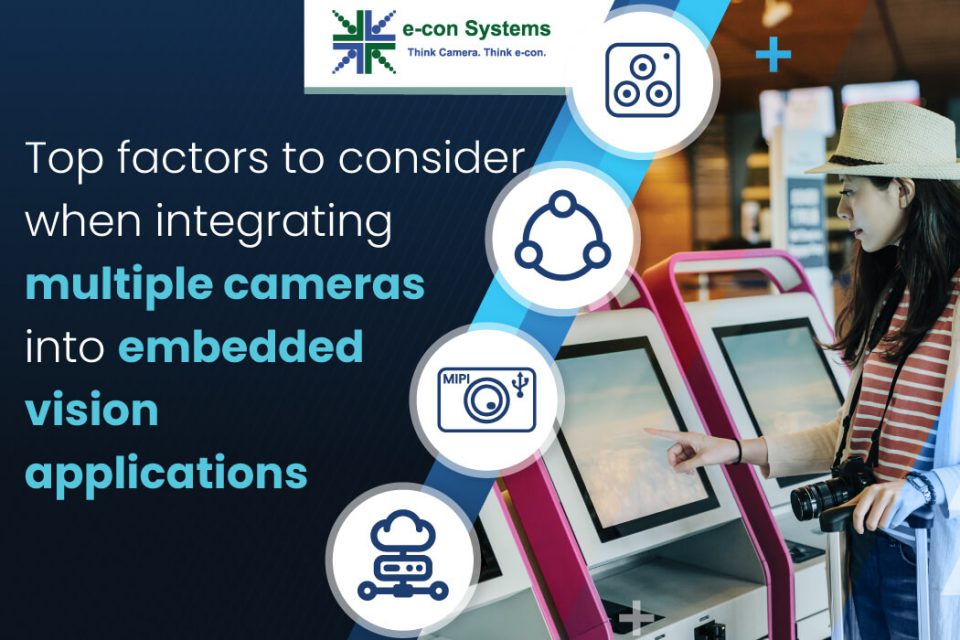Multi-camera systems offer a wide array of possibilities across industries, providing a broader and more comprehensive view of the scene. From industrial automation to surveillance and virtual reality, the integration of multiple cameras allows enhanced visual data capture and analysis.
In this blog, we’ll explore the critical factors you should take into account when integrating multiple cameras into your camera-enabled system. We’ll also delve into practical use cases, synchronization methods, camera interfaces, and the ideal host platform for optimal performance.
Use Cases: Synchronized and Non-Synchronized
Before unraveling the key factors, let us explore the scenarios in which synchronization and non-synchronization are required for effective multi-camera setups.
Airport Kiosk – Non-Synchronized Setup: In airport kiosks, multiple cameras serve diverse functions like iris recognition, facial recognition, and document scanning. Although each camera contributes to the system’s functionality, synchronization is not required as their functions operate independently.
Delivery Robots – Synchronized Setup: Delivery robots that need a 360° or 180° view rely on multiple cameras with stitched images. Here, camera synchronization becomes crucial to ensure accurate data capture and enable real-time navigational decisions.
Factors to Consider When Integrating Multi-Camera Systems
The factors that play a crucial role in the successful integration of multi-camera systems are:
- Number of Cameras
- Synchronization Method
- Camera Interface
- Host Platform
Let us now look at each of the above factors in detail.
Number of Cameras
The first crucial consideration is determining the number of cameras you need. This decision depends on various factors, such as the level of accuracy and details required, the nature and position of the target object, the desired field of view, and the processing power of your host platform. Opting for a higher number of cameras can provide benefits like higher resolution, reduced lens distortion, and a broader field of view.
Synchronization Method
Synchronization plays a pivotal role in multi-camera systems to ensure that all cameras capture images or frames at the same time. There are two main synchronization methods to consider:
Software Synchronization: For capturing static objects in controlled environments where frame-level synchronization is not critical, software synchronization is recommended. This method relies on software algorithms to align captured frames, providing a practical solution for scenarios where precise synchronization is not essential.
Hardware Synchronization: For capturing moving objects with improved accuracy and synchronization, hardware synchronization is recommended. This method involves initiating simultaneous image capture in all cameras through a hardware trigger, like an external PWM signal. This ensures perfectly aligned frames and is ideal for embedded vision applications requiring real-time decisions.
Application Scenarios of Software and Hardware Synchronization: To further illustrate these concepts, let’s consider a couple of examples. An example of the software synchronization method would be a 3D scanning device used for the reconstruction of objects. In this case, the target object doesn’t move, and the task is typically carried out in a controlled lighting environment. Here, the software-based synchronization method will work effectively.
On the other hand, examples of hardware synchronization include surround view systems in fleets and remotely controlled vehicles, as well as automated sports broadcasting and analytics systems. These applications require precise synchronization to capture simultaneous and accurately aligned frames from multiple cameras.
Camera Interface
The camera interface is another crucial factor to ponder, primarily driven by bandwidth requirements. In applications where high-resolution images need to be captured at high frame rates, a MIPI interface is preferred over USB. Additionally, factors like data transfer distance, reliability, and host platform compatibility also influence the choice. For high-bandwidth data transfer beyond 2 to 3 meters, consider interfaces like GMSL2 or FPD-Link III.
Host Platform
Selecting the appropriate host platform is vital for optimal performance and compatibility with your multi-camera system. Consider factors such as processing power, form factor, and cost when making this decision. Various processors are available in the market, with the NVIDIA Jetson series being a popular and advanced option. Other choices include NXP i.MX series, Qualcomm, and Texas Instruments. When selecting a processor, it is crucial to consider various factors, including AI performance measured in TOPS, power consumption, thermal performance, maximum camera support, required interfaces, and software ecosystems.
e-con Systems: Leading the Way in Multi-Camera Solutions
e-con Systems boasts a wealth of experience in the integration of multi-camera systems. With a proven track record, we have successfully performed numerous multi-camera integrations across diverse industries, including industrial, retail, smart city, medical, and sports sectors.
What sets us apart is our robust partner ecosystem, collaborating with renowned sensor manufacturers such as Sony, onsemi, and OmniVision. As an esteemed partner of NVIDIA, the leading-edge processor provider, we ensure cutting-edge technology and innovation for our customers.
Simplifying the camera evaluation process is one of our key strengths Our comprehensive range of multi-camera solutions supports 2-8 cameras in a single system, readily available for your needs. Moreover, our team provides extensive customization services, tailoring the camera setup to precisely meet your unique application requirements.
Explore our Multi-Camera Solutions page or visit our Camera Selector page to see our complete portfolio.
For any camera integration inquiries or assistance, don’t hesitate to reach out to us at camerasolutions@e-consystems.com.
Elevate your imaging experience with multi-camera systems today!

Suresh Madhu is the product marketing manager with 16+ years of experience in embedded product design, technical architecture, SOM product design, camera solutions, and product development. He has played an integral part in helping many customers build their products by integrating the right vision technology into them.




